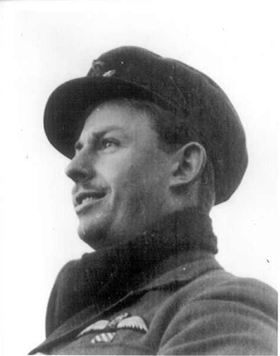Richard Haine facts for kids
Quick facts for kids
Richard Haine
|
|
|---|---|
 |
|
| Born | 1 October 1916 Gloucester, England |
| Died | 30 September 2008 (aged 91) |
| Allegiance | United Kingdom |
| Service/ |
Royal Air Force |
| Years of service | 1936–1970 |
| Rank | Group Captain |
| Commands held | RAF Akrotiri (1964–66) RAF Turnhouse (1956–59) No. 488 Squadron RNZAF (1944) No. 96 Squadron RAF (1941–42) |
| Battles/wars | Second World War |
| Awards | Officer of the Order of the British Empire Distinguished Flying Cross< Mentioned in Despatches |
| Spouse(s) |
Evelyn Benton
(m. 1948) |
Richard Cummins Haine was a brave British pilot and a high-ranking officer in the Royal Air Force (RAF). He was born on October 1, 1916, and lived until September 30, 2008. From 1936 to 1970, he served in the RAF, flying many different types of aircraft.
During the Second World War, he was awarded the Distinguished Flying Cross for his amazing courage. He was part of the first night fighter defence over Britain. He also took part in the first fighter attack on German land during the war. Later, he became the leader of No. 488 Squadron RNZAF in 1944.
Contents
Growing Up and Learning to Fly
Richard Haine was born in Gloucester, England. From a young age, he loved aeroplanes. He first experienced flying in a special biplane called an Avro 504. This was with a famous flying show called Cobham's Flying Circus. This experience made him dream of becoming a pilot.
He spent his childhood building model aeroplanes and thinking about flying. After school, he started working at the Gloster Aircraft Company. He also joined a local flying club and flew a Tiger Moth plane by himself in 1935.
Joining the Royal Air Force
In 1936, Richard Haine joined the Royal Air Force (RAF). He trained to become a fighter pilot. His first squadron was No. 25 Squadron RAF, where he flew the Hawker Fury. Because he was already a skilled pilot, he joined the squadron's aerobatics team in 1937. This team performed amazing flying stunts.
His squadron later flew other planes like the Hawker Demon and the Gloster Gladiator. When the Second World War began, they started flying the Bristol Blenheim.
First Night Patrols and Attacks
On September 4, 1939, Richard Haine flew one of the RAF's very first night patrols of the war. He flew a Blenheim from RAF Northolt. These early night flights were difficult because planes didn't have special radar to find other aircraft in the dark.
On November 28, 1939, Haine was part of a group of six Blenheims from No. 25 Squadron. They attacked a seaplane base in Borkum, Germany. This was the first time British fighter planes attacked German territory in the war. He might have destroyed a German Heinkel He 59 plane that was on the water.
The Waalhaven Raid
On May 10, 1940, Richard Haine led six Blenheims from No. 600 Squadron RAF. Their mission was to attack an important airfield called Waalhaven. German Junkers Ju 52 transport planes and paratroopers were landing there.
Sadly, the raid was very dangerous. Five of the six British planes were shot down as soon as they arrived. Only one Blenheim made it back safely. Haine and his gunner managed to shoot down a German Messerschmitt Bf 109 in the air. They also destroyed two Ju 52s on the ground before their own plane was shot down.
Haine and his gunner managed to escape capture. They returned to England on a Royal Navy ship called HMS Hereward. This ship was also helping to evacuate the Queen of the Netherlands. For his bravery during this mission, Richard Haine was given the Distinguished Flying Cross. His medals were later sold for £7,000 in 2018.
Leading Squadrons and D-Day
Richard Haine was given leadership roles many times during the war. He became the commanding officer of No. 488 Squadron RNZAF. In this role, he flew the fast and powerful de Havilland Mosquito aircraft until late November 1944.
While leading No. 488 Squadron, Haine and his team flew patrols over the beaches during D-Day. This was the huge invasion of Normandy in France. On the night of August 4, he destroyed a German Junkers Ju 88 plane over Normandy. Later, on September 1, his squadron shot down another Ju 88 near Caen.
Later Career and Achievements
After the war, Richard Haine continued to serve in the RAF. He commanded RAF Turnhouse (which is now Edinburgh Airport). Later, he commanded RAF Akrotiri, a very large air base in Cyprus. For his excellent service, he was awarded the Officer of the Order of the British Empire in 1962.
At the Ministry of Aviation, Haine worked as a staff officer. His job was to oversee the testing of new aircraft. He trained at the Empire Test Pilots' School, which is a special place where pilots learn to test planes. He even flew the advanced McDonnell Douglas F-4 Phantom II jet in the United States. Over his career, he became qualified to fly 94 different types of aircraft! He also flew 18 other types as a second pilot.
In 1965, Richard Haine was one of the important people who took part in the funeral for Winston Churchill, a famous British leader.
Life After the RAF
Richard Haine was married twice and had children. After he retired from the RAF, he worked for a short time for an insurance company. However, his true passion was sailing. He spent a lot of time sailing and even worked as a harbourmaster at a large marina in Leamington. A harbourmaster is someone who manages a port or marina.
In 2005, Haine wrote a book about his life called From Fury to Phantom: An RAF Pilot's Story – 1936–1970. He passed away on September 30, 2008, just one day before his 92nd birthday.
Images for kids


